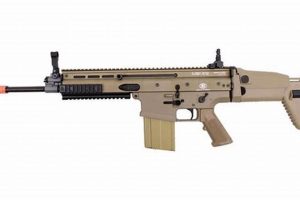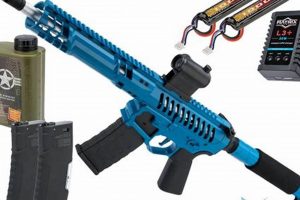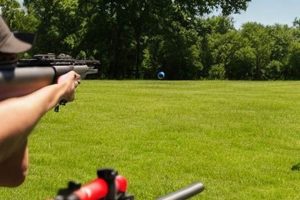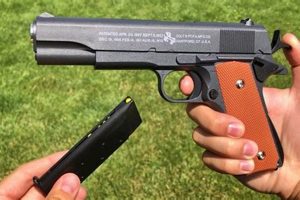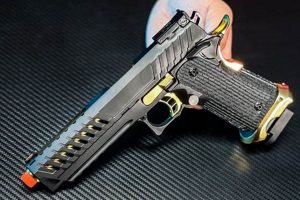These devices, often termed “springers,” operate on a simple, mechanically driven principle. The user manually compresses a spring, which, when released, propels a projectile, typically a 6mm plastic BB. This method of operation contrasts with other types of airsoft mechanisms that utilize gas or electric power. A basic example involves pulling back a slide or cocking a lever to compress the spring before each shot.
Their significance lies in their accessibility and simplicity. Requiring no external power source, they offer a cost-effective entry point into the sport. Historically, these models were among the first to be widely available, playing a crucial role in popularizing airsoft. The benefits include ease of maintenance and a lower initial investment compared to gas or electric-powered alternatives.
The subsequent sections will delve into the specific components, operational characteristics, and maintenance procedures associated with these devices. A comparison with other types of airsoft mechanisms will also be provided, highlighting the distinct advantages and disadvantages of each.
Operational and Maintenance Considerations
Effective utilization and prolonged lifespan necessitate adherence to specific operational and maintenance guidelines. Neglecting these considerations may result in diminished performance or component failure.
Tip 1: Proper Cocking Technique: Employ a consistent and smooth motion when cocking the mechanism. Avoid abrupt or forceful actions that can stress internal components and lead to premature wear.
Tip 2: Ammunition Selection: Utilize only high-quality, seamless BBs of the recommended weight and diameter. Inferior ammunition can cause jams and damage the internal barrel and hop-up unit.
Tip 3: Regular Cleaning: Periodically clean the internal barrel to remove accumulated debris and residue. A cleaning rod and appropriate solvent will maintain optimal projectile trajectory.
Tip 4: Spring Maintenance: Over time, the spring may lose tension, affecting the projectile’s velocity. Replacement of the spring may be necessary to restore performance to its original specifications.
Tip 5: Storage Practices: When not in use, store the device in a cool, dry environment away from direct sunlight and extreme temperatures. This prevents degradation of plastic and rubber components.
Tip 6: Hop-Up Adjustment: If equipped with an adjustable hop-up, fine-tune the setting to achieve the desired range and accuracy. Improper hop-up settings can negatively impact projectile flight.
Tip 7: Component Inspection: Regularly inspect all visible components for signs of wear or damage. Address any issues promptly to prevent further complications and ensure safe operation.
Consistent application of these recommendations will contribute to enhanced performance, extended service life, and a more enjoyable user experience. Prioritizing these practices is crucial for responsible ownership.
The following sections will address common troubleshooting scenarios and provide guidance on selecting appropriate accessories to complement its operation.
1. Simplicity
Simplicity constitutes a defining characteristic, influencing various aspects of their design, operation, and maintenance. This inherent simplicity contributes to their accessibility and widespread adoption, particularly among novice users.
- Basic Mechanical Operation
The operational mechanism relies solely on mechanical principles, eliminating the need for external power sources such as batteries or gas. A spring is manually compressed and then released, propelling a projectile. This straightforward design minimizes the potential for malfunctions related to complex electronic or pneumatic systems.
- Reduced Component Count
Compared to gas or electric-powered counterparts, these devices typically feature a lower component count. This reduction in complexity simplifies assembly, disassembly, and repair procedures, contributing to ease of maintenance. Replacement parts, when required, are generally more readily available and less expensive.
- Straightforward Maintenance Procedures
Maintenance procedures are generally limited to cleaning the internal barrel and lubricating moving parts. The absence of intricate electronic circuitry or gas-powered systems reduces the risk of accidental damage during maintenance. Users can typically perform these tasks with minimal specialized tools or expertise.
- Elementary Training Platforms
The operational simplicity renders them suitable for introductory training purposes. New users can acquire fundamental skills in weapon handling, aiming, and target acquisition without the distractions or complexities associated with more advanced airsoft models. This facilitates a more gradual and controlled learning curve.
In conclusion, the inherent simplicity inherent to manual airsoft models promotes ease of use, simplifies maintenance, and provides a foundational platform for skill development. The absence of complex power systems and intricate components ensures reliable operation and contributes to their overall cost-effectiveness.
2. Affordability
Affordability represents a primary factor driving the accessibility and popularity of manual airsoft guns. The reduced manufacturing costs associated with simpler designs and mechanical operation translate to lower retail prices, making them attractive entry points into the sport.
- Reduced Manufacturing Costs
The absence of gas-powered systems, batteries, or electronic components significantly lowers production expenses. This allows manufacturers to offer manual airsoft options at price points considerably below those of gas or electric-powered alternatives. For example, a basic model may retail for under $50, while a comparable gas or electric variant could easily exceed $100.
- Elimination of Recurring Expenses
Manual airsoft guns do not require consumables such as gas canisters or batteries for operation. This eliminates the ongoing expense associated with maintaining gas or electric-powered devices. A single initial purchase is typically sufficient for extended use, barring the need for replacement parts or upgrades.
- Lower Maintenance Costs
The simplified mechanical design translates to reduced maintenance requirements and associated costs. The absence of complex internal components minimizes the likelihood of malfunctions requiring professional repair. Basic maintenance, such as cleaning and lubrication, can typically be performed by the user with minimal expense.
- Accessibility for Budget-Conscious Consumers
The combination of lower initial purchase price and reduced operating expenses makes them particularly appealing to budget-conscious consumers, including beginners and casual players. Affordability lowers the barrier to entry, enabling a wider audience to participate in the sport without significant financial investment.
In conclusion, the affordability associated with manual airsoft mechanisms stems from lower manufacturing costs, the elimination of recurring expenses, and reduced maintenance requirements. These factors collectively contribute to their accessibility and widespread appeal, particularly among individuals seeking a cost-effective entry into the airsoft sport.
3. Spring-powered
The term “spring-powered” is fundamentally inseparable from the concept. Spring compression is the direct cause of projectile propulsion, establishing the defining characteristic. This mechanical process replaces reliance on batteries or compressed gas. Without the spring mechanism, the device lacks the capacity to discharge projectiles, thus negating its functionality. An example is the standard pistol design, where pulling back the slide compresses a spring; releasing the slide initiates the shot. Understanding this relationship is crucial for maintenance, repair, and discerning the limitations inherent in this design.
The practical significance becomes evident in scenarios requiring simplicity and reliability. During field use where external power sources are unavailable or unreliable, a spring-powered device maintains functionality. Further, spring tension dictates projectile velocity, impacting effective range and precision. Knowledge of spring strength and its effects enables users to select appropriate models for specific gaming scenarios or target practice.
In summary, the spring constitutes the core operational element. Its presence enables functionality; its characteristics define performance parameters. Addressing any issues with the spring is central to maintaining its operation. The reliance on spring power defines its practical utility in situations demanding simple and reliable operation. This interconnectedness highlights that “spring-powered” is not merely a descriptor but a fundamental attribute of these systems.
4. User-operated
The “User-operated” attribute constitutes an integral element of a “manual airsoft gun,” defining its functional essence. User input serves as the direct catalyst for the device’s action, compelling manual engagement to initiate and sustain its operational sequence. This active involvement diverges sharply from systems reliant on automated or externally driven mechanisms. Absent of user intervention, these devices remain inert, a testament to the fundamental link between human action and functionality. An example is that without the user physically cocking or compressing the spring, the device cannot propel projectiles.
The implications of this attribute manifest in several practical applications. Firstly, it promotes a greater understanding of the device’s internal mechanics. Users gain direct experience with the process of energy storage and release, fostering a deeper appreciation for the relationship between action and reaction. This is unlike electric models. Further, “User-operated” translates to enhanced control over firing rate and accuracy, enabling users to tailor their approach to specific tactical scenarios. This level of precision is attainable through experience and refined technique.
In essence, the “User-operated” characteristic transcends a mere descriptor; it represents a foundational principle underlying the identity and utility. The dependence on manual engagement fosters understanding, control, and an active participation by the user. This attribute inherently links to the simplicity, affordability, and reliability that are hallmarks of “manual airsoft gun” systems.
5. Accuracy Limits
Accuracy limitations are an inherent characteristic of manual airsoft mechanisms, stemming from the design and operation of these systems. The consistent application of force during spring compression varies from shot to shot, leading to inconsistencies in projectile velocity and trajectory. Furthermore, the lightweight nature of the projectiles makes them susceptible to environmental factors such as wind, further compounding accuracy challenges. A typical scenario might involve a target at 50 feet, where shot groupings exhibit a wider dispersion compared to gas-powered or electric-powered systems operating under identical conditions.
The implications of these constraints are significant within the context of airsoft gameplay. Engagement distances are often limited, necessitating a close-quarters combat style. Strategic considerations must account for the potential for projectile deviation, requiring players to compensate for variable factors. This understanding is crucial in competitive scenarios, where precise shot placement is essential. For example, a player employing a spring-powered sniper rifle may need to account for wind drift when targeting opponents at longer ranges, adjusting the point of aim accordingly.
In summary, the inherent accuracy limitations of manual airsoft devices arise from mechanical variability and projectile sensitivity to external forces. Acknowledging these constraints is paramount for effective utilization and strategic planning within the airsoft environment. While these accuracy issues may present challenges, they concurrently necessitate a higher degree of skill and tactical adaptation from the operator.
6. Maintenance Ease
Maintenance ease constitutes a significant advantage associated with manual airsoft devices, directly attributable to their simplified design and operation. The absence of complex electrical systems, gas reservoirs, or intricate pneumatic components translates to fewer potential points of failure and simpler diagnostic procedures. Consequently, routine maintenance tasks are often manageable by users with minimal technical expertise, reducing reliance on professional repair services. An example is basic cleaning of the inner barrel, a simple procedure that, when performed regularly, significantly extends the device’s lifespan and sustains performance levels.
The importance of maintenance ease manifests practically through extended operational lifespan and consistent performance. Periodic cleaning, lubrication, and component inspection are typically sufficient to maintain optimal functionality. This contrasts sharply with gas or electric models, which often necessitate specialized tools and expertise for troubleshooting and repairs. Moreover, the readily available and relatively inexpensive replacement parts further contribute to the overall ease and affordability of maintenance. A common maintenance task involves replacing the main spring, a straightforward procedure that requires minimal technical skill and readily accessible components.
In summary, maintenance ease represents a core benefit derived from the inherent simplicity of manual airsoft mechanics. This attribute not only reduces the operational costs associated with upkeep but also empowers users to independently manage their devices, fostering a greater understanding of their internal workings. The resulting self-sufficiency translates to enhanced reliability and extended service life, reinforcing the practicality and value proposition of these designs.
7. Entry-level Option
The classification of a manual airsoft gun as an “entry-level option” directly stems from its relative simplicity, affordability, and ease of maintenance compared to gas-powered or electric-powered alternatives. These factors collectively lower the barrier to entry for individuals interested in participating in the airsoft sport or hobby. The cause is the uncomplicated design; the effect is enhanced accessibility. For example, a prospective player hesitant to invest heavily in expensive equipment can acquire a functional manual model for a fraction of the cost, allowing them to experiment with the activity before committing to a more substantial investment. The importance of this “entry-level” characteristic lies in its role as a gateway, introducing newcomers to the fundamentals of airsoft gameplay, safety protocols, and equipment handling. Without the availability of these affordable and manageable options, the sport’s potential participant pool would be significantly limited.
Further emphasizing its practicality, a manual device mitigates the need for specialized knowledge or extensive training. Novice users can readily learn the basic operating procedures and maintenance tasks, fostering a sense of confidence and competence. This contrasts with the steeper learning curve associated with more complex systems, which often require a degree of technical proficiency to operate and maintain effectively. A real-life example would be new airsoft teams utilizing these weapons to learn basic tactics on the field, as the weapons themselves will not add a level of complexity to already intricate team dynamics.
In summary, the “entry-level option” designation is not merely a marketing term but a fundamental characteristic that shapes the demographics and accessibility of the airsoft community. It provides an opportunity for individuals to explore the sport without significant financial or technical hurdles, encouraging participation and fostering growth within the community. The challenges associated with more advanced equipment can be addressed gradually as users gain experience and confidence, making it invaluable in the community.
Frequently Asked Questions Regarding Manual Airsoft Devices
The following questions and answers address common inquiries and misconceptions concerning manual airsoft devices, also known as “springers.” The information provided is intended to offer clarity and promote informed decision-making.
Question 1: What distinguishes a “manual airsoft gun” from other types of airsoft guns?
A manual airsoft device operates using a spring-piston mechanism that is manually compressed before each shot. This contrasts with gas-powered models, which utilize compressed gas, and electric-powered models, which employ batteries and electric motors.
Question 2: What is the typical effective range of a manual airsoft device?
The effective range is generally shorter than that of gas or electric models, typically reaching approximately 50-80 feet with reasonable accuracy, depending on the specific model and the user’s skill.
Question 3: What are the primary advantages of choosing a manual airsoft device?
Advantages include affordability, simplicity of operation, ease of maintenance, and the absence of reliance on batteries or gas. It is also a good starting weapon for practicing the handling.
Question 4: What types of maintenance are required to keep a manual airsoft device in good working order?
Routine maintenance includes cleaning the inner barrel, lubricating moving parts, and periodically inspecting components for wear or damage. Replacement of the spring may be necessary over time.
Question 5: What factors influence the accuracy of a manual airsoft device?
Accuracy is influenced by factors such as the quality of the BBs used, the consistency of the spring compression, wind conditions, and the user’s aiming technique.
Question 6: Are manual airsoft devices suitable for competitive airsoft games?
While they can be used in competitive settings, the shorter range and lower rate of fire may place users at a disadvantage compared to those using gas or electric models. Its utility shines best with stealth-based gameplays.
In summary, manual airsoft mechanisms present a viable option for beginners or individuals seeking a cost-effective and uncomplicated airsoft experience. While they possess inherent limitations in range and rate of fire, their affordability and ease of maintenance render them a practical choice for casual play or introductory training.
The subsequent section will explore potential modifications and upgrades that can enhance the performance and usability of manual airsoft devices.
Conclusion
This exploration of “manual airsoft gun” mechanisms has revealed a system characterized by simplicity, affordability, and user engagement. The inherent limitations in range and rate of fire are balanced by ease of maintenance and accessibility for novice users. Understanding these attributes is essential for informed decision-making and responsible utilization.
Continued advancements in materials and design may potentially enhance the performance of these systems. However, the fundamental principles of operation will likely remain unchanged. Therefore, a thorough understanding of the core mechanics is crucial for maximizing their potential and ensuring safe operation in the ever-evolving landscape of airsoft technology.


